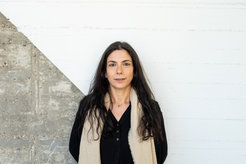"This is us" - Questions for Nour Tawil
Our institute has over 300 employees. But that is just a number. Who are the people at our institute? What do they do and what drives them? In our "This is us" format, colleagues answer questions about their work and their motivation.

On the occasion of International Women's Day on March 8, 2023, we started the series “This is us” with 15 female scientists from our institute. We are picking up where we left off and introducing the scientist Nour Tawil from the Lise Meitner Group for Environmental Neurocience. In the last episode we introduced Elisa Buchberger from the Center for Lifespan Psychology.
One of your research topics at the Lise Meitner Group for Environmental Neuroscience are the effects of architecture on the human brain with a focus on living environments. What fascinates you about this topic?
Having a background in architecture and almost two decades of professional practice, I’ve always been intrigued by the impact that the spaces we inhabit can have on us. It’s fascinating for me to study how our living environments can affect our brains and behavior, especially in today’s world, where we spend the majority of our time in and around buildings. Understanding the psychological and neural mechanisms behind these effects is crucial, as it can inform evidence-based strategies that aim to optimize spaces in ways to enhance cognition, foster mental health and well-being, and support a healthier life.
You currently investigate the influence of different contours on emotions and behavior in your Ph.D. What results are you expecting? Can you give an example of what influences us in our daily life?
The influence of contours on our emotions and behavior is quite intriguing. Previous evidence suggests that curved shapes are generally preferred over angular ones. In our research, we have found similar effects when it comes to architecture and interior design. For instance, in one experiment, we observed that people tend to prefer interiors with curved features and find them more relaxing compared to angular designs. We’ve also identified a connection between contours and approach-avoidance behavior: curvature is associated with the approach, while angularity is with avoidance. Ultimately, understanding these influences can help us create everyday spaces that evoke positive emotional states.
What are the challenges you face as a scientist?
As a scientist, who comes from an industry background, I do face certain challenges. One of them is adapting to the different pace and priorities of academic research, which often involves longer timeframes compared to industry projects. Another challenge is transitioning from a more applied and practical mindset to a research-oriented approach that requires a deeper focus on theory and methodology. Additionally, there may be a learning curve in terms of acquiring the necessary academic research skills and techniques. However, despite these challenges, my industry experience brings valuable perspectives in project management, as well as problem-solving skills that can contribute to innovative and practical research outcomes.
What do you appreciate about the Max Planck Community?
The Max Planck Community offers a remarkable environment for scientific endeavors. One aspect I truly appreciate is the culture of interdisciplinary collaboration. It’s incredible how researchers from around the world come together, exchange perspectives, and work towards innovative solutions for complex scientific challenges. The community also provides a supportive research environment, that encourages scientific independence, creativity, and long-term projects. Moreover, the opportunities for career advancement, solid mentorship, and access to a vast network of experts are invaluable. Being part of this inspiring and rewarding scientific community allows for continuous learning and career progression.
